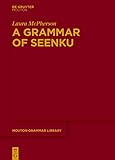A Grammar of Seenku / Laura McPherson.
Material type: TextSeries: Mouton Grammar Library [MGL] ; 83Publisher: Berlin ; Boston : De Gruyter Mouton, [2020]Copyright date: ©2020Description: 1 online resource (XX, 572 p.)Content type:
TextSeries: Mouton Grammar Library [MGL] ; 83Publisher: Berlin ; Boston : De Gruyter Mouton, [2020]Copyright date: ©2020Description: 1 online resource (XX, 572 p.)Content type: - 9783110612950
- 9783110765021
- online - DeGruyter
- Issued also in print.
| Item type | Current library | Call number | URL | Status | Notes | Barcode | |
|---|---|---|---|---|---|---|---|
 eBook
eBook
|
Biblioteca "Angelicum" Pont. Univ. S.Tommaso d'Aquino Nuvola online | online - DeGruyter (Browse shelf(Opens below)) | Online access | Not for loan (Accesso limitato) | Accesso per gli utenti autorizzati / Access for authorized users | (dgr)9783110765021 |
Frontmatter -- Acknowledgements -- Contents -- Abbreviations -- 1 Introduction -- 2 Sketch of the grammar -- 3 Segmental phonology -- 4 Tone -- 5 Nominal morphology -- 6 Pronouns and anaphora -- 7 Compound nouns -- 8 Noun phrase structure -- 9 Ideophones and onomatopoeia -- 10 Postpositions and adverbials -- 11 Coordination -- 12 Verb stems and verbal derivation -- 13 Verbal inflection -- 14 Non-verbal predicates -- 15 Comparatives -- 16 Interrogation -- 17 Relative clauses -- 18 Conditional constructions -- 19 Complement and purposive clauses -- 20 Clause coordination and event sequencing -- 21 Information structure and discourse -- 22 Artistic adaptation of language -- 23 Texts -- Bibliography -- Index
restricted access online access with authorization star
http://purl.org/coar/access_right/c_16ec
Seenku is a Western Mande language of the Samogo group spoken in southwestern Burkina Faso by approximately 17,000 speakers. It has undergone a lot of phonological reduction, leading to a rich segmental and tonal phoneme inventory but mainly mono- and sesquisyllabic roots. The language has four contrastive levels of tone that combine to create over a dozen contours. Tone has a high functional load lexically and grammatically, permeating all aspects of grammar. Most verbs have two stem forms: a realis form and an irrealis form. The realis is derived from the irrealis by infixing a high vowel before the stem vowel, creating a diphthong. The use of a particular stem form is determined by aspect and construction type, but most other morphosyntactic meanings (e.g. progressive aspect or causative) are expressed analytically. Like most Mande languages, Seenku has an S Aux O V X word order in addition to areal clause-final negation. It displays a reduced set of post-subject “predicate markers” compared to other Mande languages, and those that are attested are variably realized only by tone changes and lengthening on the subject itself.
Issued also in print.
Mode of access: Internet via World Wide Web.
In English.
Description based on online resource; title from PDF title page (publisher's Web site, viewed 28. Feb 2023)


